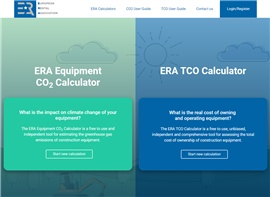“The next three years will be even harder,” LGMG chairman on the challenges facing the company at home and abroad
23 May 2025
As one of the first major Chinese construction OEMs to move into the access market in 2015, LGMG has ridden high on a wave of a booming domestic construction market, helping it to expand into European and US markets. But since then, company chairman Yu Mengsheng says the company has had to face a slowing domestic market and the introduction of trade tariffs on many of its exports. Euan Youdale reports from China.
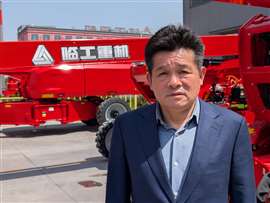 Yu Mengsheng, LGMG chairman. Photo: KHL
Yu Mengsheng, LGMG chairman. Photo: KHL
“The past five years have been hard, but for many the next three years will be even harder.”
So says Yu Mengsheng, the chairman of Lingong Heavy Machinery (LGMG), one of the world’s top ten biggest access platform manufacturers.
As one of the first major Chinese construction OEMs to move into the access market in 2015, LGMG has ridden high on a wave of a booming domestic construction market, helping it to expand into European and US markets.
The company currently sends machines to 60 regions around the globe and some 40% of production output at its vast Jinan site is access equipment, complementing LGMG’s longstanding mining product division.
Post-pandemic challenges
But, since the pandemic, Yu says, the company has been beset by a long list of challenges including stalling domestic growth, a highly competitive Chinese rental sector, the introduction of anti-dumping and anti-subsidy tariffs on MEWPs imported from China to the EU, US import tariffs and becoming the subject of an investigation by the UK Health & Safety executive after one of its machines was involved in a serious accident.
“In 2015 we thought there would be 10 years of growth in the Chinese market, but it turned out to be only five,” Yu says. “Before [2019] the market was very robust and everyone made a profit.”
Fierce competition in the market led manufacturers to offer machines to rental firms on wildly attractive long payment terms – many of which ended up never being fulfilled.
“As the big rental companies grew, fierce competition was introduced to the market, which brought down prices and overall profit,” Yu says. “Many players in the market have been averse to sensible risk management.”
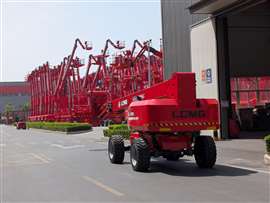 Part of the LGMG factory in Jinan, China
Part of the LGMG factory in Jinan, China
With its domestic economy slowing since the pandemic and the Chinese government not spending as much on mega project construction, Yu says Chinese customers have not been buying in the same sort of numbers.
In addition, he says, LGMG and its competitors have become victims of their own success. The reliability of China-produced equipment has proven to be high, meaning MEWPs can have a 10-year life cycle and therefore many customers are not seeking to replace their fleets.
Overseas sales too are facing roadblocks.
This year the European Commission introduced new anti-dumping and anti-subsidy tariffs on MEWPs imported from China to the EU.
The move has led many MEWP manufacturers to set up production facilities outside China in order to avoid the added charges.
LGMG started production in its highly-automated 15,000-unit capacity Mexico factory, located in Monterrey, in December 2023 but at present has no European production facilities.
The company says this new plant can accommodate production for the US market, and some for the increasing demand in Europe. However, the company estimates that currently 99% of the equipment it sells to European buyers is produced in China and is therefore incurring duties of around 30%.
Moving production out of China
While the company’s Mexican factory, with its 15,000-unit capacity, can meet some of Europe’s total demand, it won’t be able supply all of it, says Yu. “We produce a wide range of equipment there but most of it will be for the US market.”
LGMG originally had a 4,600 square meters branch facility in Rotterdam and three years ago built another 18,000 square meters warehouse for parts and distribution.
“We were the first [Chinese manufacturer] in Europe to set up a branch in the continent,” says Yu, “And the first to set up a parts centre.” However as yet there is no production on the continent.
Therefore, the plan is to set up production facilities in Europe, with part of that strategy being to find a suitable partner on the continent. Whether that will involve an acquisition in the region Yu cannot yet confirm.
More distressingly for Yu, one of the company’s latest products, the SR2024E rough terrain scissor lift, was involved in a recent accident in the UK and is currently being investigated by the UK’s Health and Safety Executive (HSE).
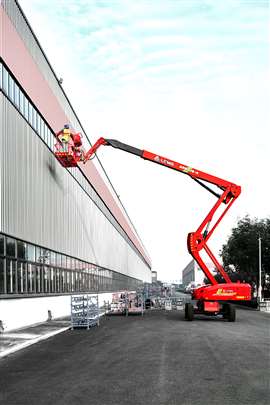 LGMG’s AR20JE lift in action. Photo: LGMG
LGMG’s AR20JE lift in action. Photo: LGMG
“We feel very sorry for those people affected by this. Nobody wants to see an incident like this, especially the families that have been involved,” he told Access International.
LGMG says it will provide all the support it can to the HSE and the investigation. (See more details in the box below).
Yu added that LGMG prides itself in the quality of its products. “We have been in business for 11 years and never had any issues like this, in China, the UK or anywhere else.”
“We understand the concerns following the recent incident. As the official investigation continues, we encourage everyone to await its findings before making any judgements.”
Yet, despite the all-too-real challenges of the present, LGMG is optimistic for the long-term prospects of the access platform market, both in China and overseas.
As far as the US market is concerned, the outlook is positive, believes Yu, with big construction projects, and increased sales there for LGMG over the coming months. There is an increasing market for articulated boom lifts, while construction relating to new energy and data centres, for example, is providing major opportunities.
Meanwhile in China the company predicts that the total number of MEWPs operating in China alone will rise significantly from around 800,000 now to 1.2 million in the next five years, driven both by a rebound in the construction sector in big cities but also by growth in the country’s vast rural areas.
“In time demand will come back through the reconstruction of large shopping malls and high-rise buildings, says Yu, “But for real growth the government must put more effort into new buildings.”
Yu believes that with equipment prices down, it means small outfits in rural areas can afford to invest in it, replacing traditional forms of working at height.
“There is a population of 1.4 billion in China and there are more than 10,000 small towns. At the moment, you seldom to see access equipment there, but there are pockets and this will grow,” he says. “Access equipment is penetrating areas outside the main cities, where it has grown very fast in the past, and into county level.”
Chinese rental market matures
On top of that the rental market in the country is becoming more mature. Some of the smaller rental companies have ceased operation, while the larger rental companies have started increasing their rental rates, explains Yu.
Furthermore, those small family-owned businesses, which are increasing their demand for access equipment, are looking for short term, 10 to 20-day rental, and the industry is seeing a shift away from the longer-term rental model.
“For strong companies the most difficult times are over, and the market is slowly getting better.”
And, LGMG is hoping that the Chinese government could introduce new safety standards requiring access platforms to be used when working at height.
LGMG is actively working with associations to lobby for specific MEWP standards to be introduced.
“If this does happen it will be a major help for the rental industry in terms of safety and growth.”
LGMG’s response to the UK accident
The incident in late March on a site in Northampton, saw the platform of an SR2024E rough terrain scissor lift detach from the scissor stack, leaving the two individuals working in the basket with significant injuries. Yu told Access International that LGMG would provide all the support it could to the HSE and the investigation.
As Yu explains, the SR2024E is a newly designed product that is CE certified. Following the incident LGMG carried out a full test of the model and confirmed that it is fully compliant with European EN280 standards. While the cause of the incident is not yet known, as the HSE continues its investigation, LGMG, in a statement released after the incident, advised its customers to temporarily suspend the use of the SR2024E model. The incident has had an impact on the company’s business in the UK, says Yu.
“Some of those customers that had placed orders are now waiting for the report [from the HSE] before picking up the equipment. Some of our old customers have not stopped investing in LGMG products, but some of our new customers are being more cautious.” Since the accident, speculation, including on social media, has been rife and in the company statement to its customers, it urged the industry to wait for the official findings of the investigation before drawing conclusions.
“Any suggestion that any LGMG machinery (other than the SR2024E) is not fit for service or should be quarantined is wholly misguided and influenced by the damaging falsehoods that have circulated in the aftermath of the incident.” “LGMG is established in 70 countries, and this incident is the first one,” Yu said. “We do not know the reason for this incident. Whatever the HSE finds we will respond appropriately to it.”
Latest launches
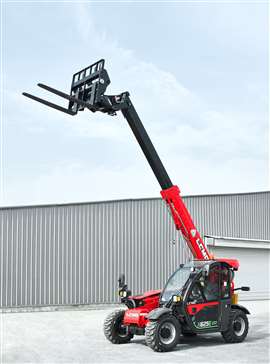 The H625E. Photo: LGMG
The H625E. Photo: LGMG
At Bauma 2025, LGMG displayed its T26JE-2 and T38J-2 telescopic boom lifts and the AR20JE-2 articulating boom lift. The T26JE-2 has a new parallelogram tower boom. The T38J-2 is equipped with an X-type chassis expansion structure for compact transportation and operations in confined areas. Both T26JE-2 and AR20JE-2 are powered by large capacity 80 V Lithium battery and equipped with PMSM (permanent magnet synchronous motor) as a lifting motor.
This advanced system integrates the motor and controller into a single, maintenance-free unit. The PMSM reduces energy depletion and operating costs. The company also displayed its largest and highest electric scissor lift, the S2012E. The lift has a maximum working height of 22m, a maximum platform capacity of 750kg, and a 1.8-meter extension deck for increased working coverage. The S2012E allows up to four people to work both indoors and outdoors. The company also displayed its first electric telehandler, the H625E.
STAY CONNECTED



Receive the information you need when you need it through our world-leading magazines, newsletters and daily briefings.
CONNECT WITH THE TEAM








